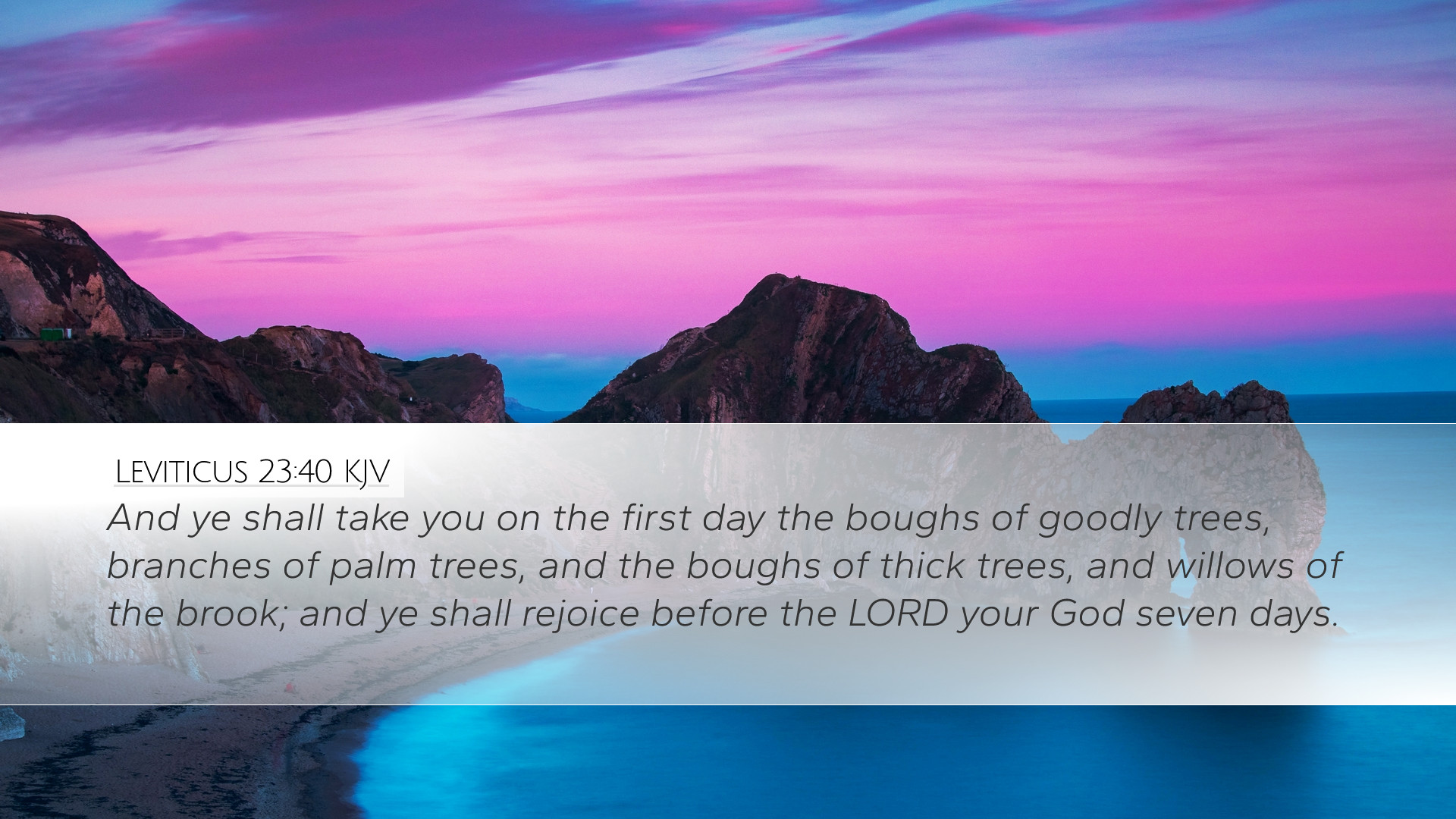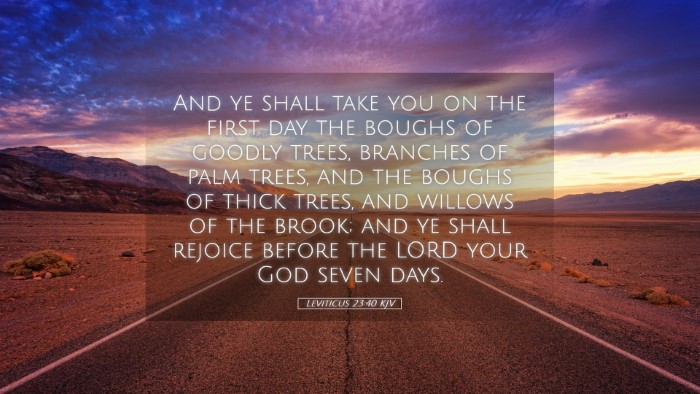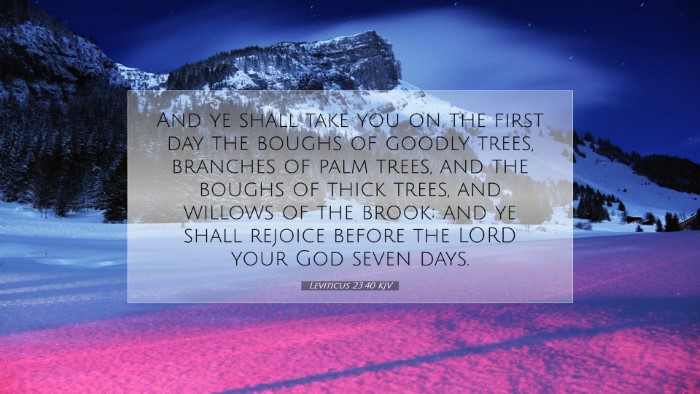Commentary on Leviticus 23:40
Introduction
Leviticus 23:40 states, "And ye shall take you on the first day the boughs of goodly trees, branches of palm trees, and the boughs of thick trees, and willows of the brook; and ye shall rejoice before the LORD your God seven days." This verse is situated within the context of the annual festival of Tabernacles (Sukkot), a significant celebration in Israel's liturgical calendar. It reminds us of God's provision and the historical journey of the Israelites as they wandered in the wilderness.
Understanding the Context
The book of Leviticus provides a detailed account of the laws and practices instituted for the Israelites. Leviticus 23 outlines appointed festivals, emphasizing the importance of each celebration, which serves as a reminder of God’s covenant with His people.
-
Historical Background:
The Feast of Tabernacles commemorates God's provision during the Israelites' 40 years in the wilderness. They lived in temporary shelters (tabernacles) as they journeyed towards the Promised Land. This festival also signifies the harvest season and reflects a time of joy and thanksgiving.
-
The Role of the Israelites:
As we interpret this verse, we acknowledge that it calls for active participation from the Israelites. They were instructed to gather specific branches and rejoice, indicating both a physical and spiritual action of gratitude towards God.
Symbolism of the Branches
The particular branches mentioned in Leviticus 23:40 carry rich symbolism. The use of "boughs of goodly trees" signifies beauty and abundance, while "branches of palm trees" represent victory and triumph. The "boughs of thick trees" and "willows of the brook" may symbolize strength and flexibility, respectively. Together, these branches illustrate the essence of rejoicing in God’s presence and provision.
Insights from Commentators
Matthew Henry
Matthew Henry emphasizes the significance of these branches as both a reminder of God's faithfulness and a representation of joy. His commentary reflects that God's people, upon gathering these branches, express their praise through the tactile engagement with nature, which engages the senses in worship and rejoicing.
Albert Barnes
Albert Barnes notes the festive atmosphere that the use of such greenery creates. He points out that these natural elements serve a dual purpose: they not only beautify the celebration but also facilitate a deeper connection to the Creator, reminding the participants of the Creator's intimate involvement in their lives. Barnes suggests that this festivity requires active participation in both worship and remembrance.
Adam Clarke
Adam Clarke highlights the necessity of joy during this festival, which is underscored by the seven-day duration of the celebration. He elaborates on how the seven days mirror the creation of the world, indicating a time for reflection on God’s creation and providence. Clarke points to the internal attitude of joy that should accompany the external actions of worship.
The Rejoicing Aspect
The call to "rejoice before the LORD your God" over seven days compels believers to recognize joy as an integral part of worship. This joy is not merely a feeling but an actionable expression of gratitude and acknowledgment of God’s sovereignty. The act of rejoicing emphasizes the community aspect of worship, as families and friends gather to participate in this communal activity.
Community and Worship
Worship in the Old Testament is often characterized by communal activities. The necessity for gathering together during the Feast of Tabernacles illustrates the importance of community in the life of faith. This becomes a time of thanksgiving that reinforces communal bonds and collective memory among the people of Israel.
Theological Implications
Beyond the historical and cultural contexts, this verse carries significant theological implications. It serves as a prefiguration of the joyful worship that is to be practiced in the New Covenant through Christ. The Apostle Paul, in his letters, repeatedly encourages believers to rejoice, reflecting the spirit of this festival.
-
God’s Provision:
Just as the Israelites remembered God's guidance and provision during their time in the wilderness, contemporary believers are called to acknowledge God's providence in their lives through Christ. The joy inherent in this festival serves as a model for the joy found in salvation and grace.
-
Creation and Praise:
The diverse elements of creation represented in the boughs remind us to engage with the world around us in a form of worship as we recognize God’s creative power. This engagement invites us to take part in the ongoing celebration of creation and the sustainability of our relationship with the Creator.
Conclusion
Leviticus 23:40 serves as a multifaceted verse rich with instruction, celebration, and theology. It calls for both a historical understanding and a contemporary application, challenging Christians today to recognize and celebrate God's continuous provision and presence in their lives. The festivities of this passage point to deeper relationships within communities of faith and toward a more profound understanding of joy in worship.


